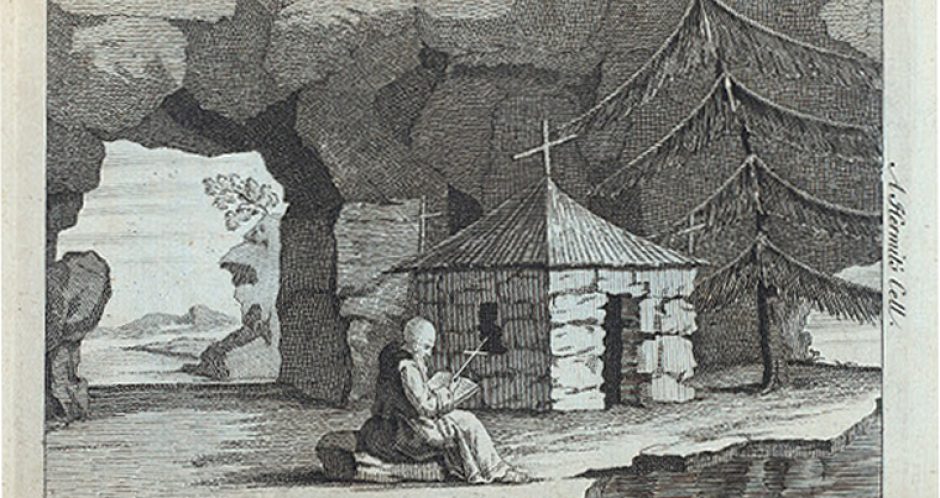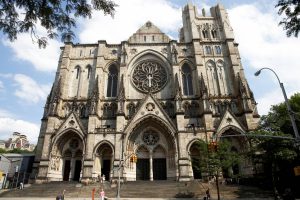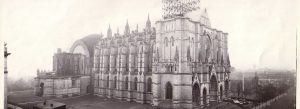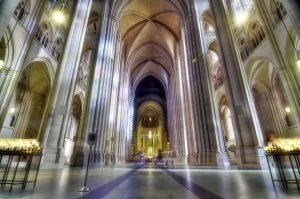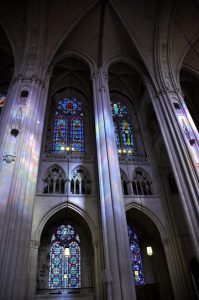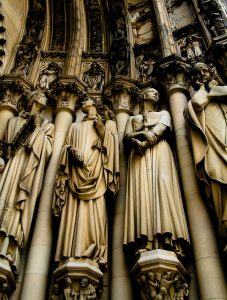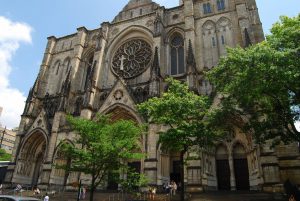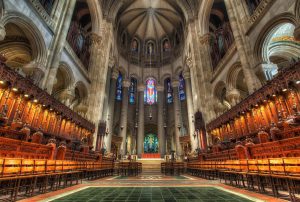St. John The Divine Church
St. John The Divine is located on 112th street and Amsterdam Avenue. The church started to be built in 1892. It is 232 feet high and 601 feet long! However, the church was never actually finished. It does have some unique features as well. St. John The Divine holds the largest Rose window in the United States. In the garden, it houses a statue with the decapitated head of Satan.
History
The initial commotion of the church started in 1892 by George Heinz, and Christopher Grant beat out 80 other competitors with a Romanesque, Byzantine design. The cathedral was, and still being constructed using traditional Gothic engineering blocks of granite, and limestone carved by master masons, and apprentices which explains its long period of construction. It took nearly 20 years for the choir, and vaulted dome crossing to be completed, and then due to the death of Heinz, a major change of architectural vision took place. It came 1911 at the hands of Ralph Adams Cram, a Gothic revival purist who insisted on a French Gothic style for the edifice,(his work also shaped Princeton University, and West Point). The first services in the nave were held the day before Pearl Harbor (1941), and construction came to a halt after the United States entered World War II. Work did not resume again until 1979, by which time stonecutters were hard to come by. In order to continue building, stonecutters came from Europe to train local craftspeople. The bishop encouraged this method as a way of giving neighborhood youths a valuable skill. In December 2001, work was halted once again following a fire that damaged the north transept. The cathedral was reopened to visitors within a month, but restoration is still not complete and the financial burden of the fire resulted in construction being temporarily abandoned. Today, construction on the cathedral is about two-thirds complete, with completion not expected anytime soon.
Architecture
In terms of Architecture, it uses vaulted arches, flying buttresses, and has high ceilings. It is the largest cathedral in the world, and is also a global landmark. The Nave shows the characteristic ribbed vaulting and pointed arches of Gothic architecture, as well as flying buttresses and the sublime stained glass windows. Like the Crossing, the Nave has a granite substructure, which above ground is faced with limestone. Cram (one of the early designers) insisted on adhering closely to the tradition of Gothic buildings. For this reason, the Cathedral has no steel or iron skeleton, and the stained glass windows are “true” stained glass, or pot-glass, made of sand and metal ash, which has been shaped and assembled according to medieval techniques. The window imagery is deliberately medieval in style and composition. The Great Rose Window, mentioned previously, holds pride of place on the western wall of the Cathedral. At forty feet in diameter, it is the third largest rose window in the world and is made of over ten thousand pieces of glass. The full length of the Cathedral—at a record-breaking 601 feet—was completed and consecrated on November 30, 1941. One week later, the attack by the Japanese at Pearl Harbor brought the United States into World War II. The subsequent economic and human mobilization brought construction to a sudden halt.
Sublime
Many people who live in the area consider the church to be sublime; they feel the church towers over them, making them feel very small. One resident in the area explains how little the church makes us feel in the world, as if our problems are no big deal in the greater scheme of things. The high pointed, cavernous ceilings of this Gothic cathedral produced sublime effects of mystery, terror, and transcendence of users of the building.
Uncanny
Like the mountains in Shelley’s Frankenstein, St John’s cathedral can be intimidating, towering over the neighborhood in which it resides. It creates an uncanny experience to be part of something big. The Cathedral’s symbolism spans from the building as a whole to the smallest corner of its windows. Designed to create a sense of uplift, awe, and human connection, architecture does its part in the Cathedral mission to be “a house of prayer for all people and a unifying center of intellectual light and leadership.”
The End
